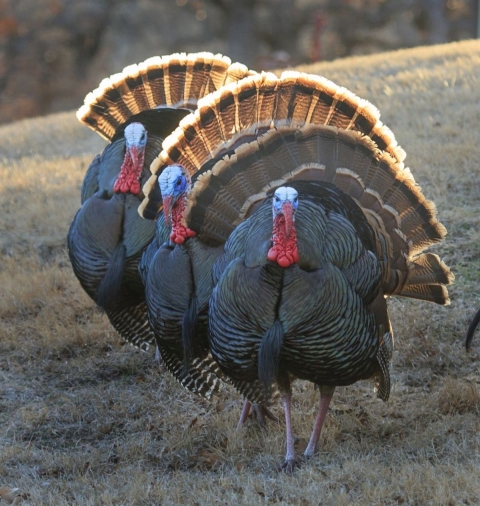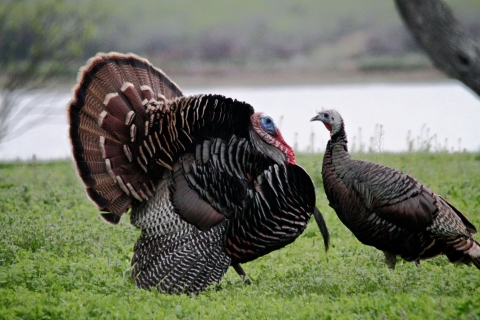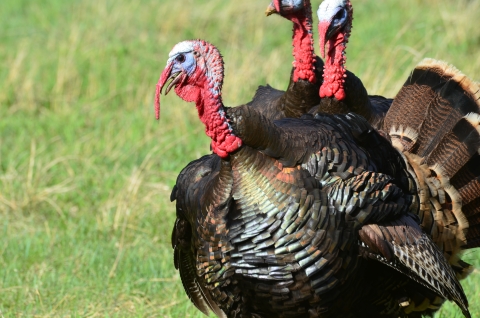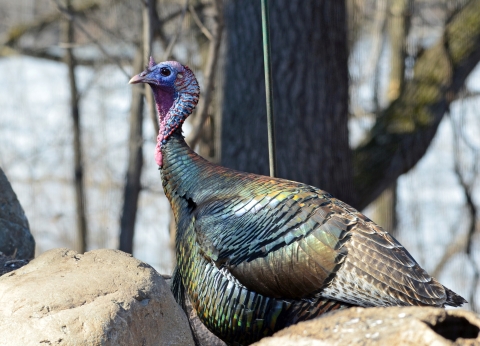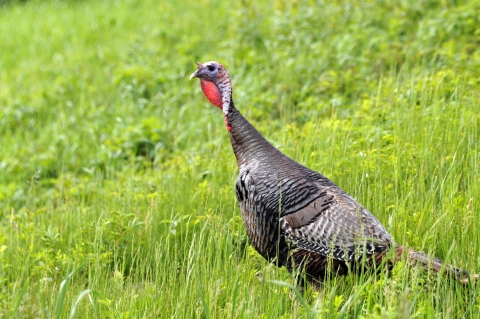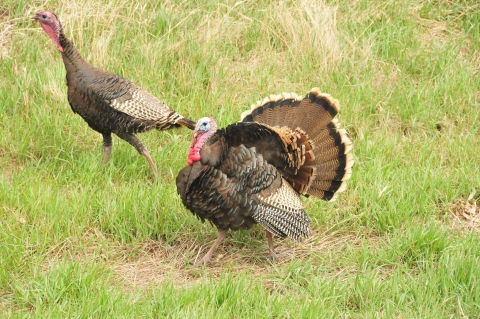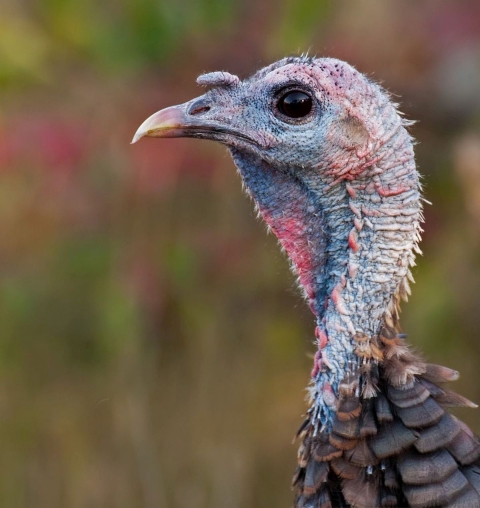November 24, 2022 - By Susan Morse - Those odd birds at your Thanksgiving table are even wilder than you thought. Amuse your guests with some offbeat turkey facts.
Then walk off the meal at a national wildlife refuge where you may you spy wild turkeys strutting and displaying. Who knows? You might emerge looking less like a butterball yourself. (Just joking.)
Read on to learn some oddball turkey trivia and wild turkey hideouts.
Wild tom (male) turkeys parade with fanned tail feathers at Wichita Mountains Wildlife Refuge in Oklahoma. A tom is also known as a gobbler. | Image Details
TURKEY FACT #1: Enough with gobble, gobble. Turkeys also cluck and purr.
TURKEY FACT #2: Turkey droppings tell a bird’s sex and age. Male droppings are j-shaped; female droppings are spiral-shaped. The larger the diameter, the older the bird.
TURKEY FACT #3: Feathers galore: An adult turkey has 5,000 to 6,000 feathers — count them!
TURKEY FACT #4: Tom turkeys aren’t the only ones that swagger and fan their tail feathers to woo mates and ward off rivals. Some hens strut, too.
TURKEY FACT #5: Young turkeys — called poults — scarf down insects like candy. Poults develop more of a taste for plants after they’re four weeks old.
TURKEY FACT #7: Move over, American bald eagle. Ben Franklin called the wild turkey a “bird of courage” and thought it would make a better national symbol.
TURKEY FACT #8: In the early 1900s, wild turkeys were on the brink of extinction, with only about 200,000 left. Through conservation efforts over the past century, with funds derived from the Pittman-Robertson Act, and thanks to sportsmen and women, there are approximately 6.5 million wild birds in the United States today, according to the National Wild Turkey Federation.
A wild turkey shows its wattle and caruncles at Parker River National Wildlife Refuge in Massachusetts. The wattle is a skin flap reaching from the beak to the neck. Caruncles are bumps of flesh that cover the birds’ necks and heads. | Image DetailsTurkey-rich refuges:
FLORIDA
St Marks National Wildlife Refuge
To boost your chances of seeing turkeys, lower your car speed to a crawl — “Turkeys are sensitive to the movement of vehicles,” says ranger David Moody — or get out and walk, slowly. Turkeys like the open terrain of the longleaf pine sandhill ecosystem along the Florida National Scenic Trail, almost 50 miles of which go through the refuge. $5 entrance fee.
GEORGIA
Piedmont National Wildlife Refuge
Look for turkeys along 50 miles of gravel roads, including 6-mile-long Wildlife Drive. You might also see turkeys off Round Oak Juliette Road, a scenic paved byway. Or try one of the refuge’s five hiking trails. No entrance fee.
ILLINOIS
Crab Orchard National Wildlife Refuge
The 1.7- mile Wild Turkey Trail leads through woods and offers a fine chance of seeing … you-know-whats. For more of a challenge, take the connecting 2.2-mile Rocky Bluff Trail. Entrance fee: $2 per vehicle.
MASSACHUSETTS
Parker River National Wildlife Refuge
Several short foot trails give you a chance to glimpse wild turkeys. You might also spy some along Wildlife Drive. Entrance fee: $5 per vehicle.
MINNESOTA
Minnesota Valley National Wildlife Refuge
From the visitor center, the half-mile Hillside Trail connects to the Long Meadow Lake Trail. Follow it around the floodplain wetland, keeping your eyes out for wild turkeys. No entrance fee.
Sherburne National Wildlife Refuge
The refuge has a “healthy population” of the skittish wild birds, says deputy manager Greg Dehmer. Look for them along 7.5-mile Wildlife Drive, two refuge hiking trails, and in prairie fields beside county roads that run through the refuge. No entrance fee.
NEW MEXICO
Bosque del Apache National Wildlife Refuge
Hundreds of Rio Grande turkeys hang out here. The North and South Auto Tour Loops are good places to spot some. Other good spots: along the Rio Viejo Trail, the John Taylor Memorial Trail or the bike trail on the east side service road of the Low Flow Conveyance Channel. Entrance fee: $5 per vehicle
NEW YORK
Iroquois National Wildlife Refuge
Feeder Road takes you on a scenic 3.5-mile drive into the refuge, passing fields and grasslands that are favorite turkey hangouts. The road is open to cars now through February, and to hikers and cyclists year-round. Three other hiking trails are also available. No entrance fee.
SOUTH CAROLINA
Carolina Sandhills National Wildlife Refuge
Nine-mile Wildlife Drive passes woods and fields where you might spot turkeys, especially in mornings and late afternoons. Or walk any of five hiking trails along the drive. An observation tower in the Oxpen Unit offers exceptional birding and scenic views. No entrance fee.
TEXAS
Hagerman National Wildlife Refuge
Look for wild turkeys crossing Refuge Road as you drive in the main entrance. Raasch Trail is also a good bet for seeing wild turkeys. No entrance fee.
Refuge trails are open sunrise to sunset daily, even on Thanksgiving Day when refuge visitor centers will be closed. Free trail maps are available outside the visitor center or at a refuge entrance kiosk.
Source: USFWS







